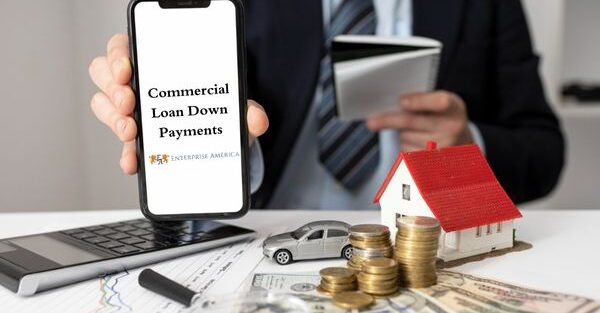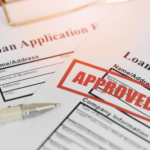What is a Commercial Loan Down Payment?
A commercial loan down payment is a percentage of the purchase price of a commercial property that you must pay upfront when you take out a loan. The down payment is used to reduce the amount of the loan that you need to borrow, and it also shows the lender that you are serious about the purchase.
Types of Commercial Loans Explained:
Explanation:
There are many different types of commercial loans available to businesses of all sizes and industries. Whatever your business’s needs and financial standing may be, there’s a loan out there that will help you succeed.
Here is a brief overview of the most common types of commercial loans:
Term loans: Term loans are the most standard form of business financing. They are typically used to finance large purchases, such as equipment or real estate. Term loans have a fixed interest rate and a set repayment schedule.
Lines of credit: Lines of credit are flexible loans that allow businesses to borrow money as needed. Lines of credit have a variable interest rate and a maximum borrowing limit. Businesses can use lines of credit to finance short-term needs, such as working capital or inventory.
Equipment financing: The term “equipment financing” refers to a special category of loans used solely for the acquisition of machinery and tools. Equipment loans typically have a shorter repayment term than other types of commercial loans, and they may be secured by the equipment itself.
Commercial real estate loans: Commercial real estate loans are used to purchase or finance commercial real estate, such as office buildings, retail storefronts, and warehouses. Commercial real estate loans typically have a longer repayment term than other types of commercial loans, and they are typically secured by the property itself.
SBA loans: The Small Business Administration (SBA) provides numerous financing programs for startups and established enterprises alike. SBA loans can be used for a variety of purposes, including starting a new business, expanding an existing business, or purchasing equipment or real estate. SBA loans typically have lower down payment requirements and longer repayment terms than other types of commercial loans.
In addition to these general types of commercial loans, there are also a number of specialized commercial loan programs available. For example, there are loans available for businesses in specific industries, such as healthcare or manufacturing. There are also loans available for businesses that are owned by women or minorities.
How Much Down Payment Do You Need for a Commercial Loan?
The amount of down payment that you need for a commercial loan will vary depending on the type of loan, the type of property, and your financial qualifications. However, most commercial loans require a down payment of at least 20%. Some lenders may be willing to go as low as 10% down, but this is typically only for borrowers with excellent credit and a strong financial track record.
Factors That Affect Your Commercial Loan Down Payment
There are a number of factors that can affect the amount of down payment that you need for a commercial loan, including:
The type of loan: Some types of commercial loans, such as Small Business Administration (SBA) loans, have lower down payment requirements than others.
The type of property: The type of commercial property that you are purchasing can also affect your down payment requirement. For example, lenders may require a higher down payment for a high-risk property, such as a hotel or restaurant.
Your financial qualifications: Your financial qualifications, such as your credit score and debt-to-income ratio, will also play a role in determining your down payment requirement. Borrowers with good credit and low debt-to-income ratios may be able to qualify for a lower down payment.
Methods for Obtaining a Business Loan with No Money
While it is rare to find a commercial loan that does not require any down payment, there are a few options available to borrowers who do not have the cash upfront. Application for a Small Business Administration loan is one possibility. The SBA offers a variety of loan programs for small businesses, including some that have low or no down payment requirements.
Another option is to look for a private lender who is willing to make a hard money loan. Hard money loans are a type of short-term secured loan in which the collateral is the actual property. Hard money lenders often have more flexible underwriting requirements than traditional lenders, and they may be willing to make a loan to a borrower with no or low down payment.
Bank Loan Down Payment Requirements: What You Need to Know
A bank loan down payment is a percentage of the purchase price of a property that you must pay upfront when you take out a loan. The down payment is used to reduce the amount of the loan that you need to borrow, and it also shows the lender that you are serious about the purchase.
The down payment requirements for a bank loan vary depending on the type of loan, the type of property, and your financial qualifications. However, most bank loans require a down payment of at least 20%. Some lenders may be willing to go as low as 10% down, but this is typically only for borrowers with excellent credit and a strong financial track record.
Here are some of the factors that can affect your bank loan down payment requirement:
Type of loan: Some types of bank loans, such as FHA loans and VA loans, have lower down payment requirements than others.
Type of property: The type of property that you are purchasing can also affect your down payment requirement. For example, lenders may require a higher down payment for an investment property than for a primary residence.
Financial qualifications: Your financial qualifications, such as your credit score and debt-to-income ratio, will also play a role in determining your down payment requirement. Borrowers with good credit and low debt-to-income ratios may be able to qualify for a lower down payment:
Shop around for a lender. Not all lenders have the same down payment requirements. Some lenders may be willing to work with you if you have a good credit score and a strong financial track record.
Consider a government-backed loan. FHA loans and VA loans have lower down payment requirements than conventional loans. However, there are some restrictions on who can qualify for these types of loans.
Get a cosigner. If you have a good credit score and a strong financial track record, you may be able to get a cosigner to help you qualify for a bank loan with a lower down payment. In the event of loan default, the cosigner assumes full responsibility for the loan.
It is important to note that making a higher down payment can have a number of benefits. For example, a higher down payment can reduce your monthly mortgage payments and the total amount of interest that you will pay over the life of the loan. You may even be able to get a better interest rate as a result.
Tips for Saving for a Commercial Loan Down Payment
If you are planning to purchase a commercial property, it is important to start saving for your down payment early. Here are a few tips:
Create a budget and track your spending: This will help you to identify areas where you can cut back and save more money.
Set a savings goal: Determine how much money you need to save for your down payment and set a realistic goal for when you want to reach it.
Automate your savings: Set up a monthly automatic transfer from your checking to your savings account to save automatically. This will help you to save consistently and reach your goal faster.
Consider investing your savings: If you have a long time horizon, you may want to consider investing your savings to earn a higher return. However, it is important to note that investing carries risk, so you should only invest money that you can afford to lose.
The No-Money-Down Method to Obtaining a Commercial Property Loan
Getting a commercial real estate loan with no down payment is possible, but it is challenging. Lenders are typically more cautious about lending money for commercial properties, as they are seen as riskier investments. However, there are a few things that you can do to increase your chances of qualifying for a no-down-payment commercial real estate loan:
Have a strong financial track record. This includes having a good credit score, a low debt-to-income ratio, and a history of paying your bills on time.
Have a well-thought-out business plan. This should include a detailed description of your business, your target market, and your financial projections.
Have a significant personal investment in the project. This could be in the form of money, sweat equity, or other assets.
Consider working with a specialized lender. There are a number of lenders that focus on providing commercial real estate loans to borrowers with no down payment.
Here are some of the types of commercial real estate loans that may be available with no down payment:
SBA 7(a) loans: The Small Business Administration (SBA) offers a variety of loan programs for small businesses, including the 7(a) loan program. 7(a) loans can be used for a variety of purposes, including purchasing commercial real estate. The SBA does not require a down payment for 7(a) loans, but lenders may require one.
Hard money loans: Hard money loans are short-term loans that are typically secured by the property itself. Hard money lenders often have more flexible underwriting requirements than traditional lenders, and they may be willing to make a loan to a borrower with no down payment. However, hard money loans typically have higher interest rates than traditional loans.
Private loans: Private lenders, such as individuals or investment firms, may also be willing to make a commercial real estate loan to a borrower with no down payment. However, private lenders typically have their own set of criteria for borrowers, and they may require a higher interest rate or other concessions.
If you are considering a commercial real estate loan with no down payment, it is important to weigh the pros and cons carefully. On the one hand, a no-down-payment loan can allow you to purchase a property without having to save up a large sum of money upfront. On the other hand, no-down-payment loans typically have higher interest rates and shorter repayment terms, which can make them more expensive in the long run.
It is also important to remember that there is no guarantee that you will be able to qualify for a commercial real estate loan with no down payment. Even if you have a strong financial track record and a well-thought-out business plan, lenders may still be reluctant to make a loan to you without a down payment.
Conclusion:
You may see that the required down payment varies greatly between loan types and between lenders. Fannie Mae Multifamily Loans, Freddie Mac Multifamily Loans, and HUD Multifamily Loans are among the government-backed loan programs that typically require the smallest initial investment from borrowers. However, only investors and enterprises with excellent credit and stable financials are eligible for these loans. Commercial property loans and small business loans from a bank or hard money lender may require a hefty down payment of 40% or more from borrowers with bad financials and less than spectacular credit. In the same way that there are many different kinds of loans, there are many different ways to raise money for a down payment, each with its own set of advantages and disadvantages. Although down payment amounts may differ from one commercial lender to the next, consumers will be better prepared for the application process if they have a good idea of what to expect.




